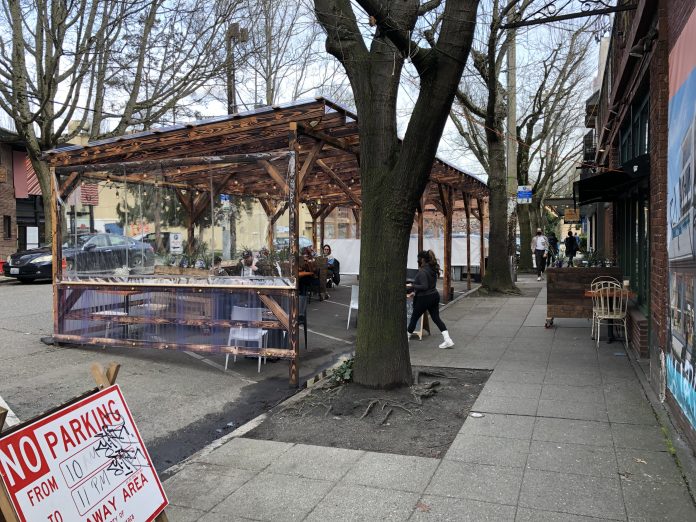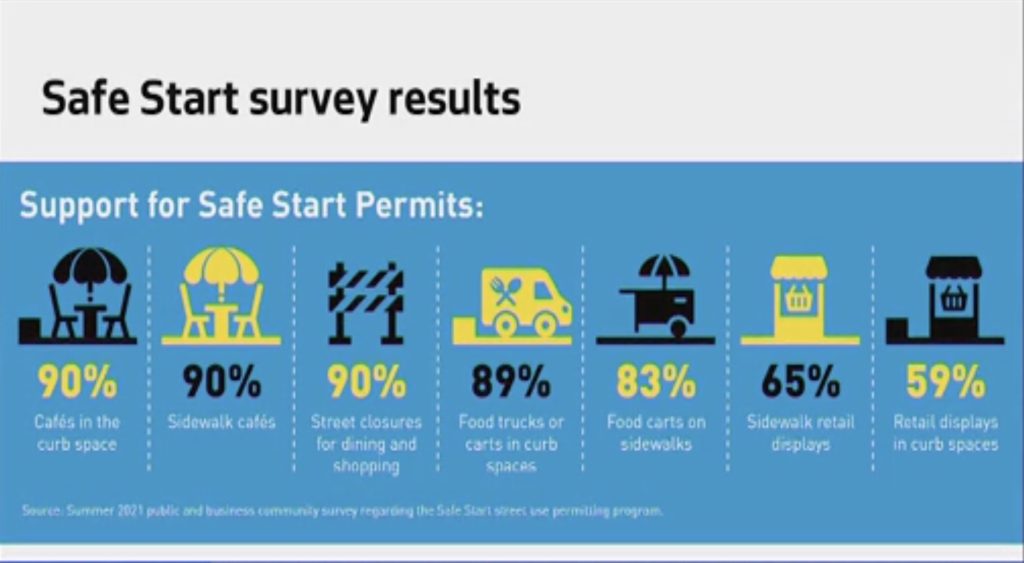
The Seattle City Council is considering a bill to extend cafe street and outdoor dining permits until January 2023. The popular program arose during the pandemic to accommodate outdoor dining and shopping through the lockdowns. While Seattle has always permitted use of sidewalk and parking spaces, the high costs were a barrier. In the 18 months since implementing the free permit program, the number of outdoor spaces used for dining and retail has increased from 400 to almost 700 locations.
The bill is sponsored by Councilmember Dan Strauss (District 6), who has been spearheading the effort to permit cafe streets. One of the more popular and extensive locations for outdoor eateries is in his district along Ballard Avenue. The Urbanist followed the story of Ballard’s unique pergolas that boosted the neighborhood’s vitality during lockdowns.
Extending free permits allows the Seattle Department of Transportation (SDOT) time to complete drafting new rules for allowing businesses to open or continue using the streets for outdoor dining and retail. According to Strauss, the new rules represent “a move from crisis response to citywide adoption and understanding that cafe streets are part of the fabric of Seattle.”
The numbers support Strauss’ observation at the program’s popularity. At the Council Transportation committee’s recent meeting, SDOT presented the results of their surveys about street retail and dining with business owners and the community. Of the 10,000 responses received in their general survey, 90% of respondents supported cafes on sidewalks and curb space as well as street closures for dining and shopping. Over 80% of respondents supported food trucks and food carts.

There was a falloff in support of retail, with just around 60% supporting merchandise displays in curb spaces and sidewalks. An argument could be made that curbside retail shops have been much rarer, with fewer well done examples. Still, a solid majority support it.
The move to a permanent cafe street program will begin in the spring as SDOT releases a package of legislation and rule changes based on these surveys and outreach to the community. SDOT detailed a work program that would allow community outreach and comment over the summer with legislation being considered in the fall. If passed, the legislation would take effect before the extension ends in January 2023.
In their presentation, SDOT said the overall goal of the outdoor dining legislation will be to create more permitting tools including seasonal permits. The department maintains a focus on safety and mobility with allowed structures that people can use year round. The agency is also looking for flexibility in retail merchandise displays, potentially allowing them based on guidelines rather than permits.
While there appeared to be general consensus around extending the current permits through January 2023, two issues arose from councilmembers looking forward to a permanent program. Councilmember Lisa Herbold (District 1) raised concerns about accessibility for everyone using the street. She requested SDOT consider actually testing some sites for accessibility, pointing to an example from New York.
Councilmember and Transportation Committee Chair Alex Pedersen (District 4) brought up a question about forgone permit revenue. SDOT calculated lost revenue from permits will be $420,000 for the eight-month extension to 2023, or an annualized cost of $630,000. This is based on the traditional calculation for permits costing between $200 and $4000 depending on the specific request and location. That higher number is for use of a parking space, with the high cost offsetting parking revenue.
In later conversation, Strauss expressed understanding for the question but emphasized that revenue can’t be compared between parking and activating a street. “It’s not an apples to apples comparison. Just trying to say something else costs X so this should cost X lacks nuance.” The fast increase in permitted outdoor spaces since the fees were waived suggests that those traditional fees were indeed a barrier, particularly when considered on top of the costs for structures and furniture to create an outdoor space.
Strauss also pushes back on the idea that Seattle’s winter weather is a damper on outdoor dining. “I was at Hattie’s Hat during the cold spell and spike in Omicron. The people I [were] with were more comfortable eating outside. It was 37 degrees and we bundled up. Outside was completely full and inside completely full. Regardless of what naysayers suggest, it was full.”
While it may sound a little Seattle Process-ish, the extra time for developing responsive, nuanced rules is probably for the best. The region has seen the issues where a city like Edmonds moves too quickly and imposes thousands of dollars in fees on outdoor dining.
“Jurisdictions having trouble are rushing to answers without doing the needed analysis,” Strauss said. “Having knee jerk reactions rather than taking the time to find the right answer.
A little extra time, Strauss argued, allows “SDOT to create the right sized policies so business can operate successfully, everyone can use the sidewalk, park when necessary, and these don’t have to be in competition. Extending to make sure we get the policies right.”
Ray Dubicki is a stay-at-home dad and parent-on-call for taking care of general school and neighborhood tasks around Ballard. This lets him see how urbanism works (or doesn’t) during the hours most people are locked in their office. He is an attorney and urbanist by training, with soup-to-nuts planning experience from code enforcement to university development to writing zoning ordinances. He enjoys using PowerPoint, but only because it’s no longer a weekly obligation.

